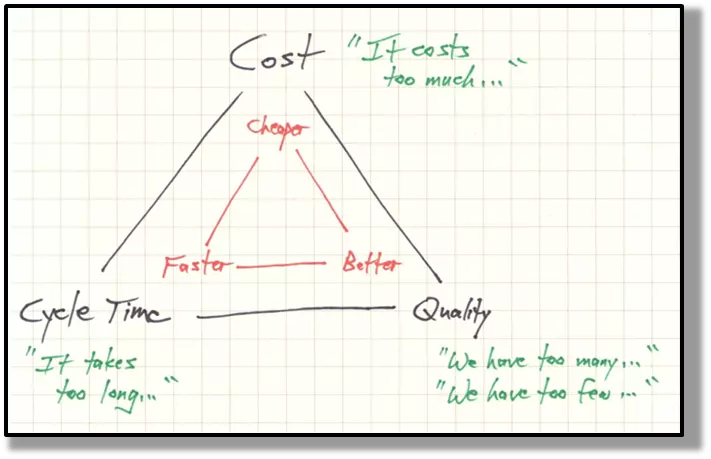
In Part One of this article, we introduced the "Process Triangle" and the role errors play in gumming up the cost, cycle time, and quality of a process. After a brief recap of Part One, we'll move on to Part Two, focusing on measuring a process and exploring the many ways quality problems manifest themselves.
Recap of Part One Key Concepts
A quick recap of what we covered in Part One& of this article:
I define "Todd's Hypothesis" as follows:
| It is impossible to ... | Reduce Process Cycle Time | or ... |
| Improve Process Quality | without also achieving ... | |
| Lower Process Cost | as a natural by-product. |
An implication of "Todd's Hypothesis" is this – Reduced Cycle Time, Improved Quality and Lowered Cost are equivalent to one another.
A process can be measured by its Cost, Cycle Time, and Quality. Visually, these measures are:

When an error occurs – either in a process itself or in its output – rework is incurred to fix the problem. By definition, an Error reduces the Quality of a process or its output, and the related Rework drives up Cost and lengthens Cycle Time. Visually, a single error looks like this:

When a process has multiple errors, it might resemble this:

A process with no errors might be this:

Errors and associated rework make the process look like a "Slinky," while an error-free process is a "straight line."
Measuring a Process
In measuring a process ...
- It's pretty easy to measure its Cycle Time.
- It's somewhat harder to measure its Cost, since you have to compute a cost for each activity in the process.
- It's much harder to measure its Quality, since you first have to define – for each activity in the process – what constitutes an error.
Some companies do track various Quality metrics for its processes, products, and services – most do not. Even if you do develop Quality metrics for some processes, these tend to be those processes where direct measurement is fairly easy – for example, the number of defects per hour for a machine making widgets.
Quality Problems Can Be Very Subtle!
Quality problems also manifest themselves indirectly, so you have to dig deeper to find the quality-related root cause. One good example is an inventory shrink. An inventory shrink occurs when a company's financial records show, for example, inventory of $1,000,000 – however, taking a physical count of all the inventory items and costing them yields only $750,000. The $250,000 difference is a physical inventory shrink.<
How is this a problem with Quality? Well, if the accounting records accurately reflected all actual transactions, there would not be an inventory shrink. What errors might occur when recording transactions?
- An error in the inventory system software does not pass all transactions to the financial system.
- An accountant books a journal entry inaccurately.
- An item's cost is maintained separately in both the inventory and financial systems, and the two costs are different.
- A worker records something in the inventory system incorrectly.
You get the point – there are many ways errors can occur when processing and recording inventory transactions.
"We Have Too Many ... " Reflects Quality Problems
More generally, I believe a Quality problem is behind most statements containing the phrase "We have too many ... "
- "We have too many accounting adjustments at month-end" implies accounting transactions were not recorded accurately the first time.
- "We have too many priority items not getting worked on by the shop" results from problems in production planning and production management.
- "We have too many items in inventory" likely means inventory reordering rules and trigger points need to be tightened, sales forecasts were too high, or production planning did not do a good job quickly adapting to a lower sales forecast.
At its root, "We have too many ... " really means "We have too many errors in one or more of our processes."
"I Need To ... " and "I Wish We Could ... " Means "We Have Too Few Resources ... "
It recently hit me that other statements I hear also reflect a Quality problem. When someone says "I need to ... " or "I wish we could ... " it typically means ...
"My company lacks the necessary skills or capacity
to do a certain project well."
Why would a company lack these skills or capacity? Because they are not needed all the time – so, it makes sense to retain such skills and capacity on an "as needed" basis.
Here are a few other examples of this ...
- "I really need to find someone to manage our system implementation ... " – Oftentimes, this means a company has tried to do a very specialized task themselves, and comes up short.
- "I wish we could get our systems to 'talk' with each other ... " – These days, virtually all systems have interface capabilities, either at the application level or through the underlying database server. The trick is knowing how to do this type of project.
- "I wish we could figure out what we really need in a new system ... " – Frequently, a company realizes it has outgrown, say, QuickBooks – yet does not know how to find something better.
- "I wish we could spend more time looking forward than backward ... " – Looking backward – for example, analyzing and reporting last month's results – is necessary. The goal when looking backward is to do the essential tasks as quickly and efficiently as possible, and thus free up time and resources to look forward. What stands in the way of achieving this goal? Typically, complex processes and inefficient use of technology, streamlining and automating processes requires specific skills.
In summary, having too few of the correct resources is also a type of Qualityproblem – if you attempt projects like these without the needed skills and capacity, you'll likely end up with a mess.
Bringing It All Together
In summary, through various examples and doodles, I hope I've helped you see the linkage of Cost, Cycle Time, and Quality – a linkage so tight that they are equivalent to each other. Of the three attributes ...
- Cycle Time is the most self-evident – it's easy to clock a process from beginning to end.
- Cost is harder to quantity – processes need to be decomposed into activities, and then the hard costs and soft costs (which are frequently MUCH higher than the hard costs!) need to be applied to each.
- Quality is sometimes tricky to identify – this is because such problems can manifest themselves in one of two ways ...
- Directly – for example, the off-quality products coming off a machine.
- Indirectly – these can manifest themselves in statements beginning with "We have too many ... " or "We need to ... " or "I wish we could ... " Drilling these down to their root indicates either the occurrence of errors in other processes, or the lack of skills or capacity to do a task right.
Pulling everything together in one final doodle ...

By the way, I'd originally planned for this article to only have two parts. Developing answers to questions on Part One from my most loyal reader – my brother Rhett! – led to new and interesting material, enough for a third part. Look for Part Three of "Todd's Hypothesis" in early 2016.
For over 26 years, Todd Herman Associates has been helping companies of all sizes and in numerous industries take their "Slinky" processes and make them into "straight lines." By doing so, we've helped our clients do things:
- Better – Quality is improved, so there are fewer "We have too many ... " or "We have to few ..." statements.
- Cheaper – Cost is lowered, and managers don't say "It costs too much ... " as frequently.
- Faster – Cycle Time is reduced, and thus executives genuinely don't have to say "It takes too long ... " as often.
How about you? If you say, or hear someone say, "We have too many (too few) ... " or "It costs too much ... " or "It takes too long ... " you now know what to do – contact me, and let Todd Herman & Associates put our experience and skills to work for you.
Sincerely,
![]()
Todd L. Herman






